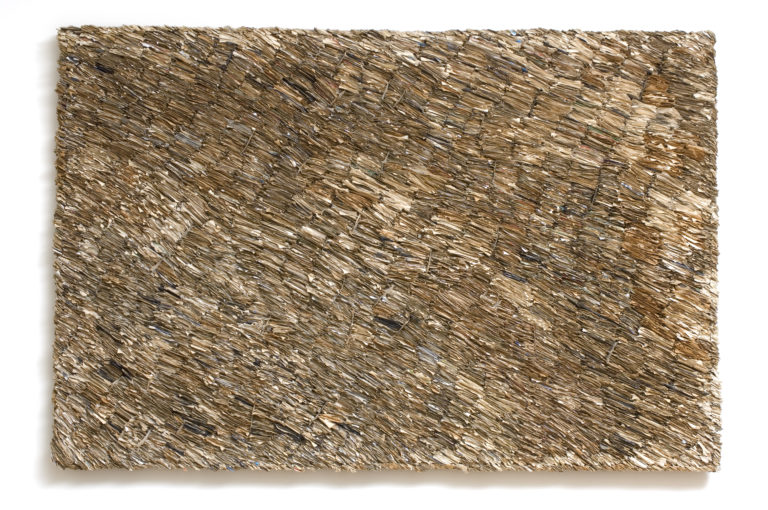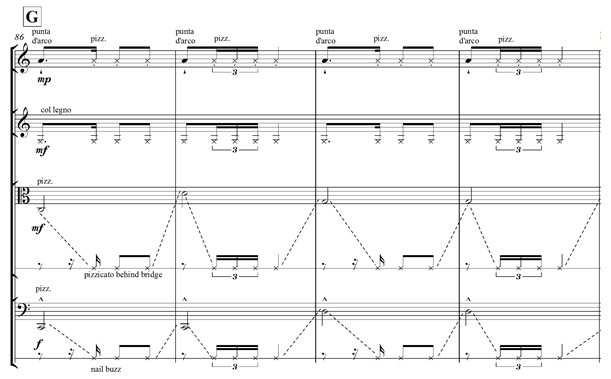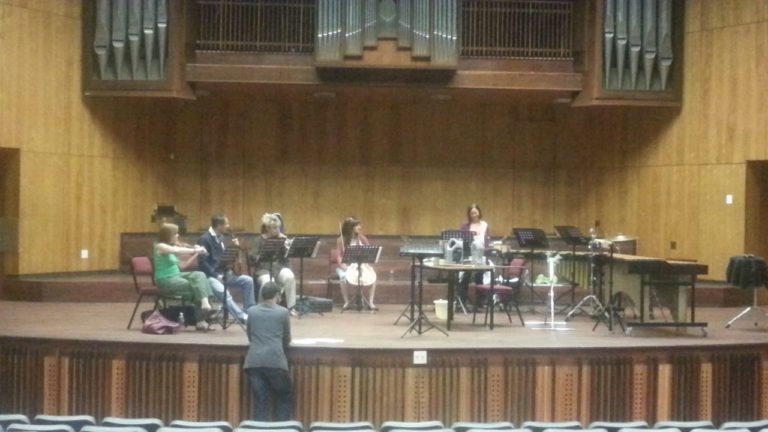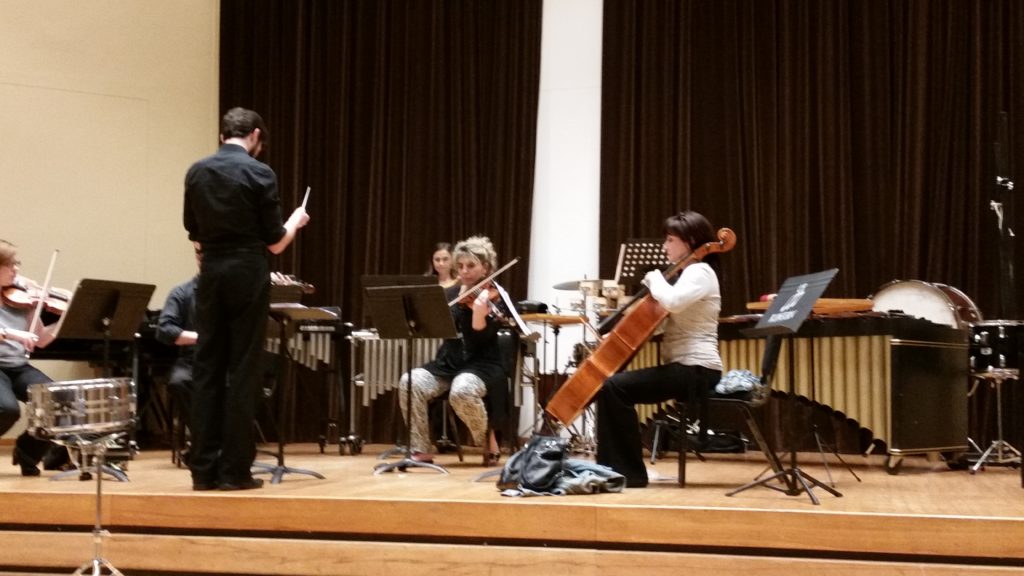
Permutationen
for percussion and string quartet
Composition Details
Instrumentation | Percussion (Crotales, Marimba, Tenor Drum) and String quartet (Violin I, Violin II, Viola, Violoncello) |
Duration | c. 4′ |
Year of composition | 2014 |
Dedication | Dedicated to Willem Boshoff Written in memory of Kobus Geldenhuys |
Other Versions
Permutationen for flute and string quartet (see Fünf Skizzen nach Kunstwerken von Willem Boshoff)
Programme Notes
Permutationen (‘Permutations’) for percussion string quartet was originally composed for flute and string quartet as part of a larger work, Fünf Skizzen nach Kunstwerken von Willem Boshoff. The instrumentation was changed so that this work could be performed by Magda de Vries and the Epoch String Quartet during a concert of the Composers National Collegium. This work is based on an artwork, Verskeur (‘Torn’), by Willem Boshoff. Verskeur was created from various pieces of torn paper and is a textured work. The music was composed to give the idea of a ‘textured landscape’ that is uneventful, similar to the artwork. Various alternative performance techniques were employed in this composition and the durations of sections were calculated using the Fibonacci sequence.
Composer’s Statement
Verskeur
https://www.willemboshoff.com/product-page/verskeur
Year: 1979
Collection: Private Collection
Material: Used paper, wood, hardboard, glue
Size: 127 x 190 cm
Description: This artwork consists of many sheets of scrap paper which are carefully arranged in a framed base of hardboard. The pieces of paper are of a particular size and arranged so that the front is made up of a side of each paper. These crumpled and torn pieces of paper are packed so tightly that there is no space between them (Boshoff, 2007:48). Boshoff (2007:48) writes that in the present day consumer society all manufactured goods can be treated as disposable. He believes that general mass production made people careless and affected the book and paper industries. “Today stacks of the finest, most perfect, white and squarely aligned paper are manufactured, and most of it ends up on dump sites or in recycle bins or in paper shredders.” (Boshoff, 2007:48.) The fact that lots of paper is thrown away inspired Boshoff to gather discarded pieces of paper on the rubbish dump over a period of one year. He then emphasized the consumers’ carelessness and tore up items he found like checque books, notebooks, notes, envelopes, letters, brochures, drawings and advertisements. He then reversed the process and treated every piece of ‘rubbish’ as a precious piece of his artwork. The manufacturing process and illegibility of the pieces of paper is reflected in the title Verskeur (Boshoff, 2007:48).

Verskeur by Willem Boshoff
Permutationen
The title of this movement for percussion and string quartet refers to the rhythmic opening motif which is divided into two smaller parts and of which ten permutations of the first part and nine permutations of the second part are heard in this movement.

Ten permutations of the first part of the rhythmic motif

Nine permutations of the second part of the rhythmic motif
Permutations and sections are so similar to one another that they can hardly be distinguished from one another. Therefore, this movement can be considered to be large texture of sounds which consists of two different timbres in each section. The first timbre is the rhythmic motifs which are played with alternative performance techniques; the focus here is on rhythm and rhythmic permutations. The second timbre is harmonics for strings which are heard in long and slow melodic lines; the focus here is on the intensification of dissonance between the harmonics. These two timbres can be compared to the different shadings of brown in Verskeur which can also be considered as an artwork that focuses on textures. The alternative performance techniques for the strings and percussion can be considered similar to the alternative way – collecting material from a rubbish dump – in which Willem Boshoff collected the material for this artwork.
Open strings are exclusively used for the rhythmic motif and its different permutations which are played with alternative performance techniques. The alternative performance techniques for the strings with which the rhythmic opening motif and its permutations are played are as follows. The first violin plays the first beat of each motif punta d’arco and the rest of the motif pizzicato. The second violin plays the rhythmic motifs col legno throughout. The viola plays the first beat of each rhythmic motif pizzicato and the rest of the motif is also played pizzicato but behind the bridge on that same string. The violoncello plays the first beat of each motif pizzicato and the rest of the motif with nail buzzes on the vibrating string.

Section from Permutationen showing alternative techniques for strings
Although this movement is textural, there are many processes present that govern the structure. The first process is the permutations of the rhythmic opening motif. These motifs in different permutations transform into the harmonics while the rhythmic motifs are continued in the percussion parts. The different permutations are placed in such a way that they continuously phase in and phase out before they are heard in unison at the end of the movement. The second process is the intensification of dissonance in the segments which consist of harmonics for all four string instruments. The lengths of these segments are also increasing and the different lengths were determined with the Fibonacci sequence, in this movement this sequence is 2+3=5+3=8+5=13+8=21.
The gradual movement between segments that are similar to one another and contrasting patterns which were derived from one another reminds of Verskeur because the different parts of the artwork are similar to one another and the contrasting shadings are created from the same material. The delicate texture of Verskeur is also reflected in the soft dynamic levels and delicate performance techniques which are required for the performance of this movement.
Recordings
This composition was recorded by Magda de Vries and the Epoch String Quartet.
Performances
20 October 2014. Composers national collegium, Musaion, University of Pretoria, Pretoria, South Africa. Magda de Vries (percussion), Lizelle le Roux (1st violin), Jacques Fourie (2nd violin), Violeta Miljikovic (viola), Maren du Plessis (violoncello) [Epoch string quartet].
21 October 2014. Composers national collegium, Musaion, University of Pretoria, Pretoria, South Africa. Magda de Vries (percussion), Lizelle le Roux (1st violin), Jacques Fourie (2nd violin), Violeta Miljikovic (viola), Maren du Plessis (violoncello) [Epoch string quartet].
16 November 2014. Composers national collegium, Fismer hall, University of Stellenbosch, Stellenbosch, South Africa. Magda de Vries (percussion), Lizelle le Roux (1st violin), Jacques Fourie (2nd violin), Violeta Miljikovic (viola), Maren du Plessis (violoncello) [Epoch string quartet].
Media


Rehearsal of Permutationen by Magda de Vries and the Epoch String Quartet at the Musaion in Pretoria
Rehearsal of Permutationen by Magda de Vries and the Epoch String Quartet at the Fismer Hall of the University of Stellenbosch
Music Score
The music score of this composition can be ordered from the composer through the contact page. Please ensure that you provide the correct title and version/instrumentation of the composition that you would like to order.